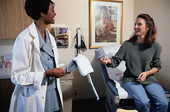
SATURDAY, April 10 (HealthDay News) — Severe peripheral vascular disease may be much more common in younger American adults and women than previously suspected, according to a new study.
The disease causes a narrowing in blood vessels that carry blood to the arms, legs, kidney and stomach and leads to symptoms that include pain and cramping in the legs during exercise.
Researchers analyzed data on 994 men and women, age 55 and younger, treated in the Wake Forest University School of Medicine Vascular Center between 1998 and 2009. They found that most of them had premature atherosclerosis (hardening of the arteries). Severe premature arterial disease of the legs (64 percent) was the most common finding.
Among the other findings:
- 130 patients had had surgery to unblock the carotid artery and improve blood flow from the heart to the brain.
- 87 patients had mesenteric vascular disease — a narrowing or blockage of one or more of the three major arteries that supply blood to the small and large intestines.
- 49 patients had repair of abdominal aortic aneurysms, which occur when a large blood vessel supplying blood to the abdomen, pelvis and legs swells and is in danger of bursting.
- 46 patients had restricted blood flow in the arms because of an embolism or blocked blood vessels in wrist and/or palm.
- 19 patients had Buerger’s disease, a rare disease of the arteries and veins of the arms and legs that can lead to infection, gangrene and amputation. The condition is strongly linked to smoking and the use of snuff and chewing tobacco.
- 192 patients (19 percent) had arterial disease in multiple organs.
- Advanced damage from hardening of the arteries was present in 88 percent of the patients.
The findings suggest a need for better detection of early clinical signs of systemic atherosclerosis, researchers said.
The study was slated to be presented Saturday at an American Heart Association conference in San Francisco.
More information
The U.S. National Heart, Lung, and Blood Institute has more about peripheral vascular disease.

